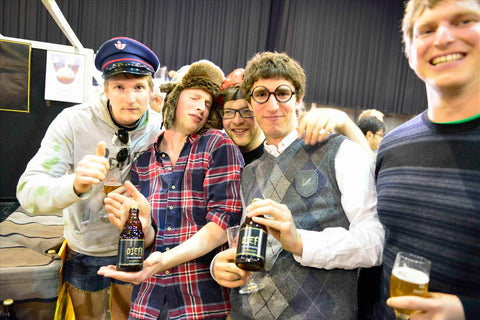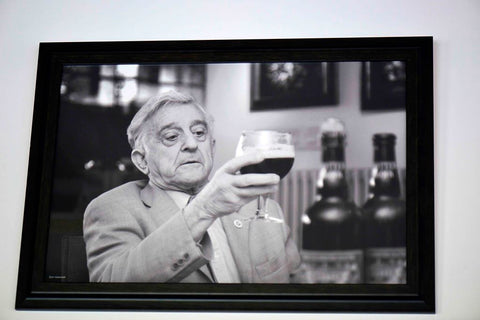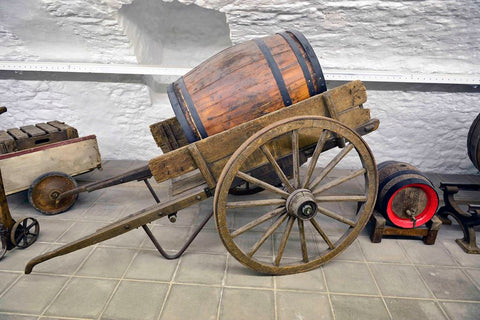- No products in the cart.
Barrel Aged Belgian Beer

Barrel ageing is an up-and-coming trend in the production of strong beers. Large and small Belgian breweries alike are maturing their beers in barrels previously used for wine, brandy, port or whisky.
The scents and tastes of barrel’s previous contents will be transferred into the young beer.
The aim is a deeper, more complex taste. The brewer must be careful, though, as excess wood tannins can also be introduced to the beer, affecting it in a negative way.
And different beers age in different ways.
Barrel ageing is especially suitable for heavy beers that are amber or dark in colour, and in which hops are not a dominant ingredient.
For some Belgian beer styles - sour beers such as Vlaams roodbruin or lambiek beers - maturing in oak barrels is nothing less than a basic requirement.
Rich Flavours

When Brouwerij Van Honsebrouck used recycled Cognac barrels to mature its Kasteel Tripel, the exclusive Trignac degustation beer was born. The taste of a Trignac is midway between beer and Cognac. It has matured just long enough so it can still be called a beer.
It is enriched with impressions of Cognac, but stops short of being turned into the spirit.
Brasserie La Binchoise’s XO, matured I Armagnac barrels, packs a punch. This is a strong, heavy brew with a complex beer taste that is complemented by impressions of fruit that are worthy of an Armagnac.
This beer will undergo a classic fermentation process in horizontal barrels. After lagering, it will be lightly dry-hopped with fresh hops. The XO will then be allowed to mature before re-fermenting in the bottle.
The Dubuisson Brewery matures its Bush Ambrée amber beer in oak wine barrels to create Bush Prestige. This method releases wood tannins as well as the sherry, whisky or cognac aromas into the beer.
Dubuisson’s Bush de Nuits is a Bush de Noël Christmas beer matured in Burgundy wine barrels. Bush de Nuits is an intriguing beer, reminiscent of a wine enhanced with touches of berries.
The Dochter van de Korenaar brewery has turned to whisky to liven up its beers.
To produce Embrasse Peat Oak Aged, the brewer takes its heavy, dark Embrasse stout and allows it to mature in recycled peat whisky barrels, lending smoky touches to the beer.
Other brewers experimenting to their hearts’ content with used oak barrels from various origins include Alvinne, De Struise Brouwers, Hof Ten Doormael, and a small army of microbrewers.
Barrel ageing is not a recent addition to Belgian beer culture, brewers using wooden containers to add flavour to their beers is a long-lived practice and can be traced back very far indeed..
Flemish Red-Brown

Flemish red-brown beers of the Rodenbach type are mixed-fermentation beers. They mature, partly or wholly, in vertical foeders made of oak, giant barrels or vats. They take on their reddish brown colour from the roasted barley malts used in the brewing process.
Traditionally these beers are brewed in the region around Roeselare, Tielt and Kortrijk (Courtrai).
They are called mixed-fermentation beers because several micro-organisms work on the beer during brewing and then during maturation in the oak foeders.
This process is largely responsible for the beer’s taste. Mixed fermentation and maturating on oak are traditional techniques to extend the storage life of the beer.
They allow some of the beer to turn sour, and this is blended with a young beer that has finished its fermentation.
These beers taste rather like wine. Although hops are used, they are barely noticeable.
The Rodenbach ingredients list also includes several roasted malts, corn meal to promote the feeling of moelleux (a gentle sweetness) and Belgian hops grown in Poperinge. The beer’s fruity character is down to that period of maturing on oak.
The De Brabandere brewery gives its Flemish red-brown Petrus beers a colour that is… blond! The brewer starts off with a blond-amber, top-fermented beer that has matured on oak for at least two years and up to three.
This ripening in oak foeders produces a fresh and slightly sour taste. The beer breathes inside the barrel, with just enough oxygen around it to support the development of up to six micro-organisms that grow on the inside of the barrel.
These bacteria do their bit to convert sugars remaining after the main fermentation into organic acids, esters and alcohol.
Omer Vander Ghinste uses a lambiek beer as the mother beer for his Cuvée des Jacobins. After brewing, the hot wort is pumped from the brewing kettle into the shallow, open cooling basin or koelschip. In the basin the exposed wort will cool down for a night.
Lambiek & Gueuze

Maturating on oak is essential for traditional lambiek beers. The wort of the lambiek is poured into the open-air cooling basin. After cooling it will start to spontaneously ferment through contact with micro-organisms in the wooden barrels it matures in. At that stage it can then be called lambiek.
The characteristic lambiek aroma can mostly be credited to two wild yeasts: the Brettanomyces bruxellensis and the Brettanomyces lambicus, both of which thrive in the Valley of the Zenne near Brussels.
After this exposure, the lambic will mature for up to three years in oak barrels.
The oak lets through just enough oxygen to promote the growth of the wild yeasts. Only ancient oak will do; new wood contains too much tannin to use in making beer.
This spontaneous fermentation process produces the very best oude gueuze, mixtures of lambiek beers that re-ferment in the bottle.
Each lambiek foeder, or barrel, is filled to the brim with its own character and will affect the taste of the oude gueuzes it gives birth to in its own specific way.
Properly produced gueuze and kriek (the cherry-flavoured variant) will be ready to drink half a year after bottling and will keep for 20 years or more. The wild yeasts will enrich the taste of the bottled beer as it ages.
It takes a long time to brew a good lambiek - the beer gains in taste and character as it matures in the foeders.
It has taken some time, but the legal authorities are now aware of the value and importance of lambiek and gueuze.
Legal protections for the styles are due to be ramped up.
In the near future, beer will only be permitted to bear the lambiek name if it meets the following strict criteria; it has to be matured in wooden barrels, be the result of spontaneous fermentation, have been cooled down in an open cooling basin and remain unsweetened and unpasteurised.
"Gueuzestekers"

Gueuzestekers, as represented by Karel Goddeau of De Cam, blend the young and old lambiek until they are satisfied with the taste. They then allow the beer to re-ferment and continue to mature in the bottle. The trade of gueuzesteker isn’t dissimilar to that of a whisky blender or Champagne master.
In the same way that a base wine is processed into a sparkling wine, a lambiek becomes an oude gueuze through a three-year maturation period.
The 'gueuzesteker' uses a number of lambiek beers to create his masterpieces. Every barrel tells its own story and so, this artisan is able to put his signature on every single one of the beers he develops.
Gueuzesteker Pierre Tilquin puts his trust in science, leaving nothing to chance. The barrels he uses are cleansed three times: at 30°C, 60°C and 80°C, and Pierre wants to be in control of the entire process up to and including bottling.
His gueuzes contain 1, 2 and 3 year old lambiek from Boon, Lindemans, Girardin and Cantillon.
Creating the right environment for the lambiek to mature is a demanding task. Pierre must fill the barrels to the rim so the risk of oxidation is minimised. He must maintain a constant temperature, and avoid any disturbance of the barrels, which are cleaned thoroughly before they are re-filled.
Mastering barrel ageing takes skill and time. It has been with us for centuries and shapes both much-loved ancient beers and exciting new creations.





